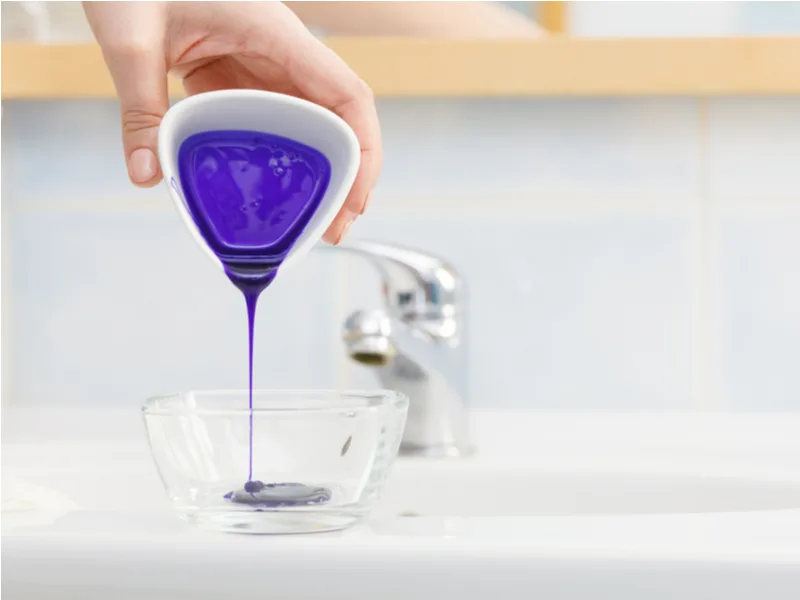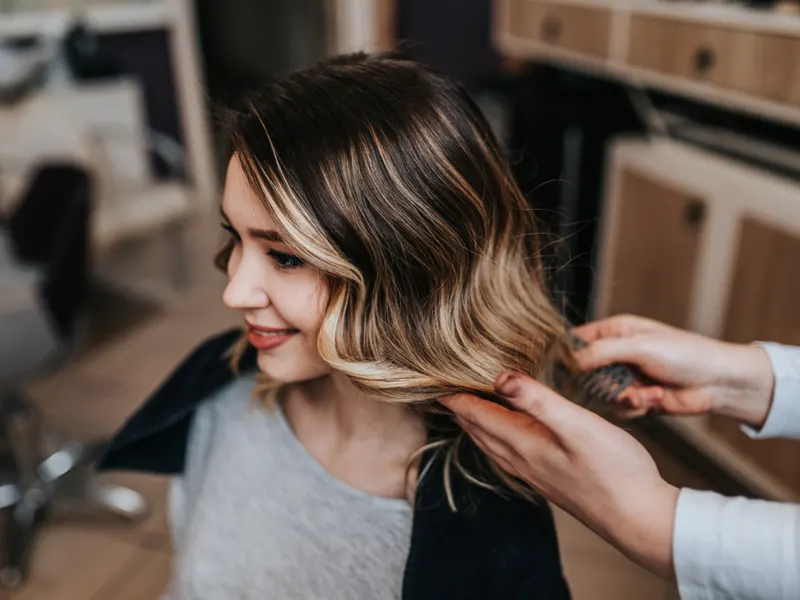Jump to:
If you grew up in the 2000s, you may hear the term highlights and immediately think of chunky, unsightly strands – but thankfully, that trend has long be laid to rest.
Today, stylists use highlights to add depth and dimension to the hair, customarily with colors slightly lighter than the natural shade. The secret to keeping your freshly painted highlights intact? Toner.
So, what does hair toner do to highlights? It completely changes the game. Read on for more information on how toner can rescue brassy, dull tones for all hair colors and textures.
What Does Hair Toner Do to Highlights?

Anetlanda/Shutterstock
Hair toners are products that enhance the existing highlights in your hair by neutralizing brassy or warm tones.
While highlights may not be as extreme as dyeing your entire head of hair, they still make a difference. And, like any hair color, highlights fade. Sometimes you get lucky, and they fade to a neutral, pleasant hue.
But at other times, they become brassy and do not blend with your additional hair colors. Enter hair toner! Your stylist may apply toner after the color application or as an add-on after your hair dries.
If you have blonde highlights, your hairstylist most likely applies toner. Most salon toners appear clear or purple and have the consistency of conditioner. Toners for dark hair are blue. Toners come in liquid or cream formulas as well as special toning shampoos.
The most common toner is purple shampoo. Regardless of the method, all toners serve the purpose of removing any unwanted brass or warm tones from highlights (or entire heads of hair, if applicable).
You Might Also Like:
How It Works
Everything you do to your hair product-wise involves some form of a chemical reaction. Don’t worry – we aren’t taking you back to high school chemistry, but understanding how toner works and its effect on your highlights can help you decide if toning is appropriate for you and your hair.
Your Hair Before Toner
Your hair comes from keratin, the same substance that forms your skin and nails. Semi-permanent and temporary dyes attach to the outer layer of hair, called the cuticle. The inner layer, or the cortex, contains the other components called eumelanin and pheomelanin.
It is within this inner layer that products like bleach and permanent dye can alter the chemistry of your hair, therefore changing the color you see. Both bleach and permanent hair dyes penetrate your hair shaft.
Permanent dye uses ammonia to reach the inner cortex, and bleach uses an alkaline solution to achieve this purpose. When your stylist finishes applying highlights, the next step is wrapping the strands in foil to insulate the hair with natural body heat.
Your body chemistry and the hair dye work together for the final result – good or bad. Toner works the same way, but the change is not as drastic. It is not as penetrating or powerful as ammonia-based dyes or bleach.
Things to Remember
Everyone reacts differently to hair color, and the same goes for highlights. If you have the following hair types or concerns, you may want to consider a consultation with a stylist before using toner:
- Extremely dark, thick hair. Highlights may not show up as well on your hair, so a salon-grade toner is your best bet.
- Thin or severely damaged hair. Lightening may damage your hair further, even just highlights. Toners, while not as aggressive, can still cause damage to already-compromised strands.
- Gray or silver hair colors. These most likely do not need toner, but if you do, a mild formula from a salon is the way to go.
The bottom line? Toners are still chemically-charged products, and even if you only use them on a few highlights, they can damage the hair follicle if your hair is not in a healthy place.
Why You Need Toner
When hair lifts from a darker shade to a lighter one, there might be some lingering brassiness that remains from your previous color. Hair shades range from 1 to 10 on the scale of darkest to lightest.
A level 10 blonde is platinum, level 5 is medium brown, and 1 is black-hued hair. When you get your highlights, ask your stylist what level of color they use on your hair, as this determines the strength of toner you should purchase.
Also, consider how many highlights you have. Are they all over your head, or only in a few layers? Minimal highlights may only need a monthly touch-up (such as a simple root bump), while significant highlights usually need a daily or weekly treatment.
Those with naturally warm undertones that want cool-toned or neutral highlights may need toning treatments.
Otherwise, your highlights will look unblended and odd against the warmth of your natural strands. Likewise, if your hair is cool-toned and you do not tone, brassy highlights stick out and look orange against your hair.
Read Next: What Hair Developer Do I Need?
What Hair Toner Does to Highlights
Hair toners are purple and blue, but some salon-grade toners may be clear if you have platinum highlights. Toners are purple or blue because those colors are the opposite of orange and yellow on the color wheel.
Applying toner to your highlights revives the original color you utilized – brassy, dull blonde becomes ashy and cool-toned, dreary caramel becomes fresh honey-hued brown, and platinum goes from yellow to pearly white.
When you apply toner to your highlights, you refresh your look at a much cheaper cost than getting your strands re-dyed.
Plus, you do not damage your hair nearly as much as with intense hair dyes. Toners change the color of your highlights on the surface, but the change is not permanent.
Which Toner Do You Need?
When it comes to toners, it is never one-size-fits-all. The history of your hair and its current color needs will determine which toner you need to purchase and the formulation that will benefit your highlights the most.
Not Just for Blondes
Although toner is frequently necessary with bleached or blonde looks, it can also be a very beneficial product for brunettes. In both cases, your toner can provide the finishing touch on your hair color that transforms it from ordinary to exceptional.
Even if the underlying color is exactly like you imagined, your look may be suffering from remaining shades from previous hair dyes, unwanted chemical reactions, or just residual pigment from your natural hair.
Though subtle, toners will refine your highlights by covering up coppery undertones. All you need to do is find the perfect match.
Formulations
As mentioned above, toner comes in several formulations. Salon toners, shampoos, masks, leave-in treatments, and mists are all toning options.
Salon-Grade Toners
Stylists use toners to adjust, enhance, or revive highlights. These toners are stronger than shampoos but still more gentle than traditional hair dyes. Salon toners will not change your hair color at its root.
Instead, they neutralize any unwanted tones or brassy patches that your highlight foils may have missed. Remember that toners are an add-on, so if you have thick or dark hair, you may sit in the salon chair longer than intended if your highlights do not absorb the toner quickly.
Shampoos
Purple and blue shampoos are the most readily available toning products. You can find them at supermarkets, cosmetic stores, and drugstores. The convenience factor is excellent with toning shampoos, but sometimes this option is not the best for highlighted hair.
As highlights do not cover your entire head, it can be challenging to get your toning shampoo where you need it – leading to patchy highlights or little to no results.
The easiest way to remedy this is to keep a brush and mirror in your shower so you can apply the shampoo directly to your highlights. Also, note that not all purple shampoos are created equal.
Some formulas are almost straight purple pigments with water added to them (these are the most intense), while some have a traditional shampoo feel and lather when exposed to water. Highlights that have blonde or white hues work best with the pigment-heavy toners.
Masks, Mists, & Other Toning Products
If you notice your hair becoming brassy after washing, hair masks are a life-saver. Toning masks are usually stronger than shampoos and need to sit on your hair for several minutes to an hour.
Another plus of masks is that you can apply them after shampoo – get out of the shower, apply your mask, and get back in when your highlights are where you want them. Mists and leave-in products are also options but are typically not as effective.
If you want precise toning for your highlights, a mist is almost guaranteed to let you down. However, leave-in products are easy to apply and keep your strands toned between washes.
Are There Any Risks for Using Toner on Highlights?
Most people do not have any issues using toner on their highlights, regardless of formulation. Applying a vibrant purple shampoo or mask every day is not the best idea.
Yes, toners are more gentle than dyes, but your highlights can quickly dry out with daily use and exposure to toning chemicals.
Before you try a new toning product, test it behind your ear. Let it sit for a few hours or minutes and watch for irritation. If you notice itching or swelling, do not use the product and contact your stylist for product recommendations.
Frequently Asked Questions

Hedgehog94/Shutterstock
Are you still wondering what a toner can do for your highlights? Here are some common questions about hair toner.
Is Toner Better Than Hair Dye?
Toner serves a different purpose than hair dye. While dye and bleach can drastically alter your hair color, toner provides more targeted improvements that enhance or correct the existing shade. So yes, toner is better for your highlights, but it still contains chemicals.
Is Toner the Same as Purple Shampoo?
Purple shampoo is a type of toner. Purple shampoos neutralize brassiness in your highlights that may come through after a few washes. However, they usually are not as potent as the ones in salons.
Can You Use Silver Shampoo as a Toner?
Yes, silver shampoo functions in the same way as purple shampoo. Marketed explicitly towards silver hair, this product tones silver or blonde hair to correct brassy or yellow shades and ensure the look is icy and cool.
Like purple shampoo, though, silver shampoo can be tricky for pinpointing specific areas and, as most people do not have silver highlights, may not produce as much of an effect.
Is There a Permanent Hair Toner?
There are both semi-permanent and demi-permanent hair toners. Often used after bleaching, toners will deposit beneficial shades back into your hair to improve balance and vibrance.
However, all toners will eventually fade as shampoo washes them away. Many people with blonde highlights wish there were permanent hair toner, but unfortunately, none currently exists.
Can I Tone My Hair at Home?
There are many professional and at-home hair toners available. If you need help finding a formula that suits your highlight shades best, ask your stylist next time you’re in the chair.
So, What Does Hair Toner Do to Highlights?
Toner revitalizes brassy and dull highlights to their original silky, shiny, and not-orange state. Blonde streaks, brunette balayage, and platinum hues can benefit from a toning treatment. With time and effort, your highlights can look salon-fresh between appointments.
